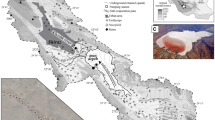Abstract
Lacustrine sediments have been widely used to investigate past climatic and environmental changes on millennial to seasonal time scales. Sedimentary archives of lakes in mountainous regions may also record non-climatic events such as earthquakes. We argue herein that a set of 64 annual laminae couplets reconciles a stratigraphically inconsistent accelerator mass spectrometry (AMS) 14C chronology in a ~4-m-long sediment core from Lake Mengda, in the north-eastern Tibetan Plateau. The laminations suggest the lake was formed by a large landslide, triggered by the 1927 Gulang earthquake (M = 8.0). The lake sediment sequence can be separated into three units based on lithologic, sedimentary, and isotopic characteristics. Starting from the bottom of the sequence, these are: (1) unweathered, coarse, sandy valley-floor deposits or landslide debris that pre-date the lake, (2) landslide-induced, fine-grained soil or reworked landslide debris with a high organic content, and (3) lacustrine sediments with low organic content and laminations. These annual laminations provide a high-resolution record of anthropogenic and environmental changes during the twentieth century, recording enhanced sediment input associated with two phases of construction activities. The high mean sedimentation rates of up to 4.8 mm year−1 underscore the potential for reconstructing such distinct sediment pulses in remote, forested, and seemingly undisturbed mountain catchments.





Similar content being viewed by others
References
Chai HJ, Liu HC, Zhang ZY, Xu ZW (2000) The distribution, causes and effects of damming landslides in China. J Chengdu Uni Tech 27:302–307
Dietze E, Hartmann K, Diekmann B, IJmker J, Lehmkuhl F, Opitz S, Stauch G, Wünnemann B, Borchers A (2012) An end-member algorithm for deciphering modern detrital processes from lake sediments of lake Donggi Cona, NE Tibetan Plateau, China. Sediment Geol 243–244:169–180
He CR, Zhang R, Chen Q, Han SL (2011a) Earthquake characteristics and building damage in high-intensity areas of Wenchuan earthquake I: Yingxiu town. Nat Hazards 57:435–451
He CR, Chen Q, Han SL, Zhang R (2011b) Earthquake characteristics and building damage in high-intensity areas of Wenchuan earthquake II: dujiangyan and Pengzhou City. Nat Hazards 57:279–292
Hou X (ed) (2001) Vegetation atlas of China. Science Press, Beijing
Keefer DK (2002) Investigating landslides caused by earthquakes—a historical review. Surv Geophys 23:473–510
Korup O (2004) Geomorphometric characteristics of New Zealand landslide dams. Eng Geol 73:13–35
Korup O, Clague JJ (2009) Natural hazards, extreme events, and mountain topography. Quat Sci Rev 28:977–990
Korup O, Tweed F (2007) Ice, moraine, and landslide dams in mountainous terrain. Quat Sci Rev 26:3406–3422
Lanzhou Earthquake Administration (1991) Lanzhou earthquakes. Lanzhou University Press, Lanzhou
Last WM, Smol JP (eds) (2001) Tracking environmental change using lake sediments. Vol 1: basin analysis, coring, and chronological techniques. Kluwer, Dordrecht
Lerman A (ed) (1978) Lakes: chemistry, geology, physics. Springer, New York
Lu SJ, Si JH (2005) Investigation of arbors in Mengda nature reserve. J Qinghai Univ (Nat Sci) 23:70–72 (in Chinese with English abstract)
Ma DT, Tu JJ, Cui P, Lu RR (2004) Approach to mountain hazards in Tibet, China. J Mt Sci 1:143–154
Meyers PA, Lallier-Verges E (1999) Lacustrine sedimentary organic matter records of late quaternary paleoclimates. J Paleolimnol 21:345–372
O’Connor JE, Costa JE (2004) The world’s largest floods, past and present—their causes and magnitudes. Geological Survey Circular, U.S 1254
Ou JP, Li H (2011) The regional engineering damage and reconstruction strategy in Wenchuan earthquake of China. J Earthq Tsunami 5:189–216
Qinghai Forestry Bureau (1990) Mengda natural reserve in Qinghai. Qinghai People’s Publishing House, Xi’ning
Reimer PJ, Baillie MGL, Bard E, Bayliss A, Beck JW, Blackwell PG, Bronk Ramsey C, Buck CE, Burr GS, Edwards RL, Friedrich M, Grootes PM, Guilderson TP, Hajdas I, Heaton TJ, Hogg AG, Hughen KA, Kaiser KF, Kromer B, McCormac FG, Manning SW, Reimer RW, Richards DA, Southon JR, Talamo S, Turney CSM, van der Plicht J, Weyhenmeyer CE (2009) Radiocarbon 51:1111–1150
Weltje GJ (1997) End-member modelling of compositional data: numerical–statistical algorithms for solving the explicit mixing problem. J Math Geol 29:503–549
Weltje GJ, Prins MA (2003) Muddled or mixed? Inferring palaeoclimate from size distributions of deep-sea clastics. Sediment Geol 162:39–62
Weltje GJ, Prins MA (2007) Genetically meaningful decomposition of grain-size distributions. Sediment Geol 202:409–424
Xu Y, Zhang JW, Su YJ (2011) Imaging the rupture of 14 April, 2010 Yushu earthquake using back-projection of global subarray P waves. Chinese J Geophys-Ch 54:1243–1250
Acknowledgments
The authors thank Bo Yang (Institute of Salt Lakes, CAS, Xi’ning) for his help during fieldwork. Special thanks go to Elisabeth Dietze and Kai Hartmann (Free University Berlin) for providing the unpublished End-Member Modeling script. Benjamin Bekeschus, Christiane Funk, Janina Stapel and Liv Heinecke (AWI-Potsdam & University Potsdam) are acknowledged for their assistances with laboratory analyses. We are grateful to Jan Blöthe (University Potsdam) for his guidance in extracting topographic data. Y. Wang’s doctoral research was funded by the “Helmholtz—China Scholarship Council (CSC) Young Scientist Fellowship” (No. 2008491101). The research was supported by the German Research Foundation (Deutsche Forschungsgemeinschaft DFG). The authors appreciate Steffen Mischke (editor), Mark Brenner (editor-in-chief), Torsten Haberzettl and one anonymous reviewer for their constructive suggestions on our manuscript.
Author information
Authors and Affiliations
Corresponding author
Rights and permissions
About this article
Cite this article
Wang, Y., Herzschuh, U., Liu, X. et al. A high-resolution sedimentary archive from landslide-dammed Lake Mengda, north-eastern Tibetan Plateau. J Paleolimnol 51, 303–312 (2014). https://doi.org/10.1007/s10933-012-9666-6
Received:
Accepted:
Published:
Issue Date:
DOI: https://doi.org/10.1007/s10933-012-9666-6




